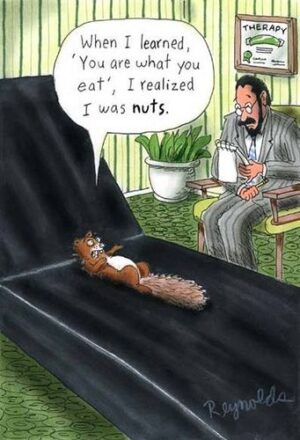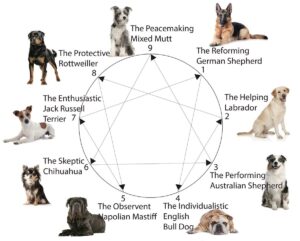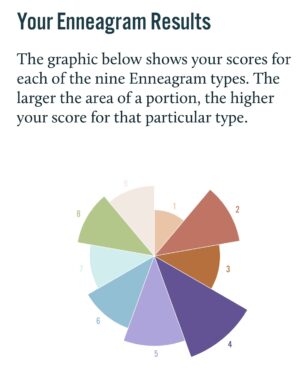
Imagine a squirrel goes to see a therapist and talks about all the areas in their life where they perceive themselves to be failing.
It turns out they’re totally useless at catching balls, scaring off cats, and cuddling up to humans.
“But hang on,” says the therapist. “Isn’t that ‘dog’ behaviour you’re describing, rather than squirrel stuff.”
“Squirrel-shmirrel,” the frustrated squirrel replies, “Let’s do dog!”
Well of course a squirrel can be trained how to be more like a dog (there are videos on YouTube for this sort of pursuit).
The therapist might help the squirrel to interact with the world in a more “dog-like” fashion. This can be an important component of our therapy journey.
But wouldn’t it be also be kinder to the squirrel, or more interesting, or self-compassionate, as well as a lot less bloody (inner) work to help our squirrel become the very best squirrel they possibly can be, rather than a different animal altogther?
In a nutshell (pardon the obvious pun), Personality-Focused Psychotherapy has the aim of helping you to do this: i.e. How To Become The Very Best Version of YOU, the very best version of your personality type.
WHAT IS PERSONALITY?

Personality is a word we often use in describing ourselves or others, but what exactly is it?
I like this description from psychotherapist, Beatrice Chestnut:
“The term personality generally refers to the part of our character that develops to interface with the outside world. Our personalities are shaped through the intersection of our innate qualities and our early experiences with parents, caregivers, family, and friends, as well as other influences in our physical, social, and cultural environments.”
When working with clients, as well as in understanding my own inner world, I have always found it useful to hold in mind some person-ality distinctions.
Therapy, it might be said, consists of one person paying close (and hopefully caring) attention to another person’s personhood. Factoring in that person’s personality, ‘blueprint’, schemas/parts/modes, can enable both therapist and client to toggle switch from the specific contents of the suffering, to more big picture thinking.
Or to use different language: holding the personality in the background can support the move from the left hemisphere part of our brain (Suffering Radio 24/7), to the right hemisphere – a quieter, more peaceful and connected place.
Personality isn’t the only ‘big picture’ force in our lives. We are each operating within specific socioeconomic conditions, have access (or non access) to certain relationships, not to mention the different ways that we each have experienced trauma. However, our personality blueprints are the lens through which we experience life. Having a notion of what our blueprint is, also helps us to see what we are not, and can act as a doorway back to our essential experience.
WHAT IS PERSONALITY-FOCUSED PSYCHOTHERAPY?
 Personality-Focused Psychotherapy helps us to grow and flourish in our own imperfect squirrel-tude (or whatever inner-animal you are), rather than everyone becoming a specific kind of person/dogs/cat.
Personality-Focused Psychotherapy helps us to grow and flourish in our own imperfect squirrel-tude (or whatever inner-animal you are), rather than everyone becoming a specific kind of person/dogs/cat.
Personality-Focused Psychotherapy is an integrative approach, which means that it takes into account these Five Factors (personality being only one of them) in order to understand and work with whatever issue you might bring to our sessions.
It borrows from a number of different personality-focused modalities, but also channels a different aspects from my training and experience. My greatest teachers have always been the hundreds of patients and clients I have interacted with and tried to assist over the years. I see my work as a psychotherapist as closer to that of a gardener than a Fix-You doctor/mechanic. I see my role of working alongside you to create the the best conditions for your growth and fulfilment as is humanly possible.
I like this quote from Karen Horney:
“You need not, and in fact cannot, teach an acorn to grow into an oak tree; but when given a chance, its intrinsic potentialities will develop. Similarly, the human individual, given a chance, tends to develop their particular human potentialities without a great deal of forcing. Favourable conditions are needed though. She needs an atmosphere of warmth to give her both a feeling of inner security and inner freedom, enabling her to have her own feelings and thoughts and to express herself. She also needs healthy friction with the wishes and wills of others. If she can thus grow with others, in love and in friction, she will also grow in accordance with her real self.”
And in so doing, become a magnificent oak tree. Or squirrel. Or snail.
HOW TO FIND OUT IF YOU’RE A SQUIRREL, A DOG, OR A MEERKAT

If what you are reading is resonating with you, perhaps you are curious to know what kind of animal you are?
I find the Enneagram personality typology to be an excellent way of doing this. Here is an overview of the Enneagram personality model: https://www.enneagraminstitute.com/how-the-enneagram-system-works
In my years working as a psychotherapist, I have studied and used all the main personality-focused typologies: Myers-Briggs/MBTI (which is often used, and perhaps even targeted at business environments), the Five-Factor Model of Personality, or Big Five (mainly used in clinical research and academic work), and even the Thematic Apperception Test, which nobody seems interested in anymore other than me.
All of these personality tests will, in different ways, alert our troubled squirrel to her squirrelhood. However, one thing that is often lacking in these models is a developmental path. Approached the right way, the Enneagram can really help to guide us in terms of our development.
Psychotherapy seeks to explore and inquire into these person-al, existential questions in many ways. Typologies like the Enneagram can be a useful resource to run in the background of that process, helping us to becoming our best squirrely, doggy, wormy, spidery, wildebeest-y selves.
If you’re interested in getting a bit of a ball-park sense of your personality typology through an Ennea lens, I would recommend the Truity Online Enneagram test. It takes about five minutes to do on your phone (I’m a lazy squirrel) and then spits out something that looks like this, my personality snapshot, below. As you can see from my results of this test, I am predominantly a Four, although I have a couple of other slices in my personality that are also key to how I function in my life.

[To read how each personality type or “slice” is framed, please consult the following primer.]
As an initial start, I would always recommend that someone do a personality test like the one above, which will allow us to begin thinking about how the issues you are facing in your life may stem, to some extent, from one of these archetypal personalities.
There are of course always other factors at work, apart from our personalities, but I find this to be the kindest way to start our therapy journey together, rather than focusing on a DSM diagnosis or the ways in which our Inner Critic tells us we’re failing at this almost-impossible task of being a talking animal (aka a human).
These explorations can become even more nuanced, as well as tailored and focused to “you” and your self-development path once we also have an idea about which of the three instinctual/hardwired capacities most drives you.
Once we have a sense of what kind of personality type you are, we can then begin looking, without judgment or blame, at how your personality both helps and hinders you in different contexts (work, family, relationships, identity).
We can then also explore how you might get the best from your core personality, as well as the various dimensions or “selves” packed into it (personalities, as you may have noticed, have lots of different components, or Parts to them). The goal, being, as I think it is for all of us: to find greater fulfilment, peace and happiness in our lives!
If this is something you’d like to look at together, please get in touch via email or telephone/WhatsApp (07804197605).

